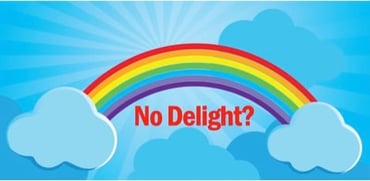If delight doesn’t lead to loyalty, what does?
I recently came across some research by the Corporate Executive Board (CEB) that has driven passionate discussions around the topic of “customer delight” and how it relates to customer loyalty and experience improvement. Namely, as articulated in this 2010 HBR article, authors of the CEB study state that their research – supported by response from some 97,000 customers proves that “delighting customers doesn’t build loyalty.”
I’m obviously late to this discussion, as there’s plenty of strong pushback to this statement (and the research that supports it) in articles from Bob Thompson and other leading voices in the arena of customer experience opinion.
Unsurprisingly, in spite of the CEB view many companies still want to “delight” their customers… after all it is clear that a good customer experience does lead to loyalty. Yet many organizations can’t even meet customer expectations. Which begs the question – to improve customer experience, where should a company focus first?
Delighting customers may lead to loyalty, but if you haven’t met expectations first, it’s not going to pay.
There’s no doubt that delivering a better experience than your competition is a competitive advantage, and helps affect loyalty. But how “good” does that experience really need to be? Many believe that wildly exceeding customer expectations is the way to do it. After all, if companies like Zappos, Nordstroms, USAA and others appear to be laser-focused on delighting their customers, it’s no surprise that the business world is scrambling to figure out how to get some of that magic.
At nearly 90 percent of companies CEB polled, the majority of organizations believes that delighting customers will lead to higher customer loyalty. And they’re right – it does. But there’s a price.
Right or wrong, the CEB study states that there is virtually no financial benefit in over-delivering on customer experience. This aligns with the business reality of almost every organization that no one can afford to delight all their customers. Given the cost, time and effort involved in doing so, it simply isn’t possible.
But there’s also little doubt that delighting the right customers, at the right time, through the right channels and interactions helps to create great experiences. Where this becomes a problem is when “delight” becomes the focus of discussion – and meeting expectations (as a decidedly less “cool” strategy) is relegated to a back burner.
Meet customer expectations first – then you can think about delight.
For almost every interaction, customers expect the experience to be certain way. When that expectation isn’t met, customers become dissatisfied - and you can’t drive customers to loyalty if they’re dissatisfied. When it comes to delivering an ideal experience, customers don’t always need to be “delighted.” But customers very much do need to have their expectations met.
One of our analytical lenses – the Kano model – helps to identify which interactions or emotions are drivers of desired loyalty behaviors. Of these, some fall into the “must meet but not required to exceed” bucket. On others, you can turn the dial up and over-deliver or delight, because customers expect and demand that you do so. Still others aren’t expected, and customers are delighted when they happen at all.
This view and other prioritization exercises helps to focus efforts. Helping focus on the right interactions, across the right journeys, for the right customer segments. And pointing to areas of unmet expectations for the most important of these as the place to start… following which a discussion of delight might begin to make sense.
So for any company trying to improve customer experience, it’s very much a “first things first” exercise. I’d summarize my perspective like this: Don’t bother trying to delight your customers… until you’re meeting their expectations – and have a system for continually doing so. And when you do go for delight, focus on those interactions that actually drive loyalty, for those customers that actually drive the greatest value.
The biggest challenge is understanding and staying ahead of customer expectations.
Not feeling the pressure to “delight” all customers all the time should be a relief to some. But make no mistake – clearly understanding and meeting customer expectations must happen, and it isn’t a simple task.
And if you don’t have a handle on that, removing dissatisfiers (much less delighting customers) is going to prove very difficult indeed. The reality is that the increasing pace of innovation and digital disruption tremendously changes expectations for what represents good customer service and what great customer experience comprises.
We all know that today’s business and consumer buyers are increasingly bringing their experiences with and expectations of “the best” experiences to every other experience they have. Which is why the evolving nature of customer expectations is where the biggest challenge lies. What once was considered “nice to have” (mobile commerce, for example) is now a basic requirement.
As customer expectations change, so must we.
Which is why those who don’t make the effort to understand what their customers expect today will be scrambling the hardest to catch up tomorrow – and those who are meeting expectations and delivering delight will be ones they’re trying to catch up to.

